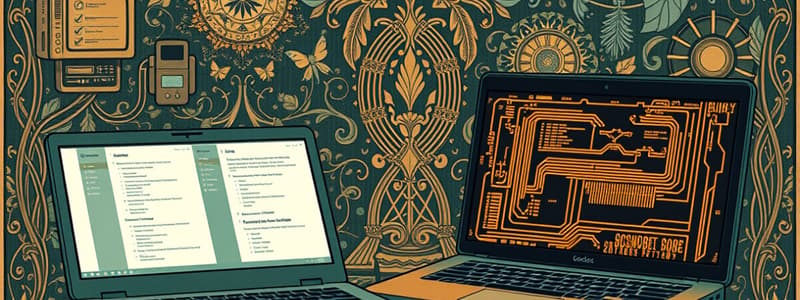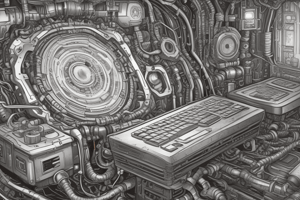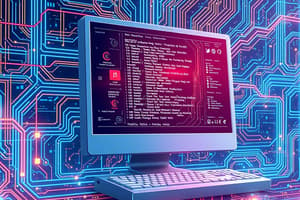Podcast
Questions and Answers
A desktop computer is generally smaller and less powerful than a laptop.
A desktop computer is generally smaller and less powerful than a laptop.
False (B)
A server is a type of device that accepts requests made by another program, known as a client.
A server is a type of device that accepts requests made by another program, known as a client.
True (A)
The motherboard is considered the core of a computer system.
The motherboard is considered the core of a computer system.
True (A)
A printer is an input device that allows users to interact with their computer.
A printer is an input device that allows users to interact with their computer.
A tablet computer usually resembles a smartphone and is designed to be held in one hand.
A tablet computer usually resembles a smartphone and is designed to be held in one hand.
A 32-bit CPU processes instructions more efficiently than a 64-bit CPU.
A 32-bit CPU processes instructions more efficiently than a 64-bit CPU.
DDR2 memory has a greater bandwidth potential than DDR memory.
DDR2 memory has a greater bandwidth potential than DDR memory.
RDRAM is known for its low cost and efficiency in processing data.
RDRAM is known for its low cost and efficiency in processing data.
The FSB transfer speed contributes to improved processor performance.
The FSB transfer speed contributes to improved processor performance.
DDR4 memory was released as the successor to DDR2.
DDR4 memory was released as the successor to DDR2.
Flashcards are hidden until you start studying
Study Notes
Introduction to Computers
- A computer is an electronic device that manipulates data, storing, retrieving, and processing it.
- Hardware refers to the physical components of a computer, while software consists of instructions that tell hardware how to function.
Types of Computers
- Desktop Computers: Designed for stationary use, larger and more powerful due to separate components.
- Laptops: Portable computers powered by batteries or AC, usable in various locations.
- Servers: Devices that accept and respond to requests from client programs.
- Tablets: Mobile devices sized like a hardcover book, capable of internet browsing and running software, primarily through touch screens.
- Smartphones: Advanced mobile phones that enable internet browsing and software usage, with touch screen interfaces.
Personal Computer Evolution
- Macintosh: Introduced in 1984, first widely sold computer with a Graphical User Interface (GUI).
- IBM PC: Launched in 1981, marking the beginning of personal computers.
Basic Parts of a Computer
- System Unit: Core component, usually a rectangular box housing essential hardware.
- Mouse: Input device for interacting with the computer screen.
- Monitor: Output device displaying video and text; also referred to as VDT or VDU.
- Keyboard: Primary input device for data entry.
- Speakers: Output devices for sound, can be integrated or external.
- Printer: External device that produces hard copies of digital data.
Internal Hardware Components
- Motherboard: Main circuit board hosting the CPU and other essential components.
- Motherboard Form Factors: Specifications determining size, power supply type, and port locations.
- CPU (Central Processing Unit): Executes instructions and performs basic operations for programs.
- Clock Speed: Measures CPU performance, indicating how many instructions are processed per second.
- FSB (Front Side Bus): Connects the CPU to system memory, affecting performance.
CPU Types
- 32-bit CPU: Older processor type, less efficient in instruction processing compared to its 64-bit counterpart.
- 64-bit CPU: More efficient in processing instructions, supporting larger data structures.
Memory Types
- Random Access Memory (RAM): Volatile memory used for temporary data storage; varying types include:
- SIMMs (Single Inline Memory Modules): Older RAM type in various sizes, usually with lower capacity.
- DIMMs (Dual Inline Memory Modules): Speedier variants designed for modern CPUs, with more pins and higher capacity.
- SDRAM (Synchronous Dynamic RAM): A memory type that synchronizes with the CPU for enhanced speed.
- DDR (Double Data Rate): Memory standard with multiple generations:
- DDR2: Released in 2003, faster and more efficient than DDR.
- DDR4: Launched in 2014, offering higher bus speeds and efficiency improvements over DDR3.
Studying That Suits You
Use AI to generate personalized quizzes and flashcards to suit your learning preferences.




